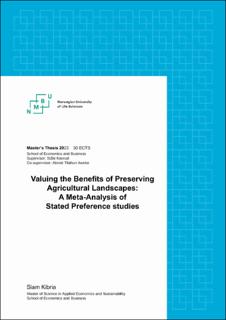| dc.description.abstract | Agricultural landscapes provide us with multiple ecosystem services, including provisioning services like crops; regulatory services like pest control, nutrient cycling, water quality management and pollination as well as cultural services like recreation, aesthetic beauty and habitats for wildlife. Many of these include non-market goods and services which are not traded in the market and lack market prices. Thus, environmental valuation studies using Revealed (RP) and Stated Preference (SP) methods are needed to value them, which can then provide the right incentives for optimal economic management of these landscapes. This thesis reviews and analyzes published SP studies worldwide in the last 15 years (2007-2022) that have used either Choice Experiment (CE) or Contingent Valuation (CV) methods to value agricultural landscapes. A meta-analysis of 17 primary SP studies with 189 estimates of willingness to pay (WTP) for agricultural landscapes across Europe, Asia, Oceania, and North America was performed to see what characteristics of the landscape, the valuation method used and the affected population determine people's (WTP) for preserving agricultural landscapes. It was also compared to an existing meta-analysis of older studies (1982 – 2008) to see whether the drivers of WTP had changed in the last 15 years. Results indicate that society’s willingness to pay (WTP) for agricultural landscapes is influenced by the size of the valued changes in landscapes, recreational services, the choice experiment (CE) valuation method, current condition of the landscape and other relevant variables. Landscape attributes such as the scarcity of agricultural lands, the direction (i.e., avoiding degradation or getting improvements) and their ecosystem services strongly influence people's preferences and WTP. Contrary to the existing meta-analysis, no significant results indicated that GDP per capita influences people's willingness to pay for agricultural landscapes. The findings provide valuable insights into the complex factors shaping people's preferences for agricultural landscapes. | |
